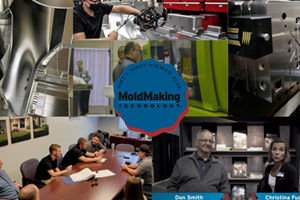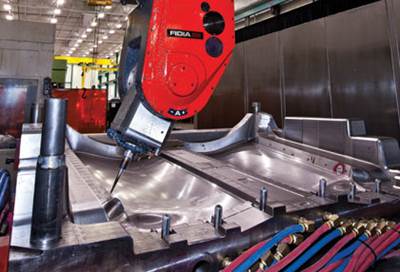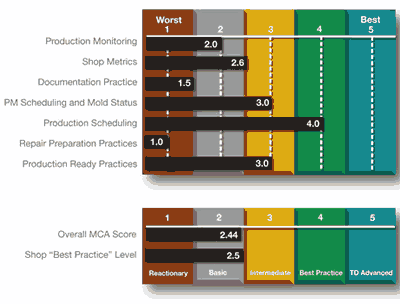Five Principles that Drive Mold Maintenance Efficiency
Individuals from companies that have embraced systemized mold maintenance share their stories.
Making significant changes in one’s business is never easy, and because of this most mold repair operations are left to follow the same old routine and just do whatever it takes to get a mold back up and making parts.
But those companies that tire of needless expense in mold repair time, tooling costs, missed shipments, quality issues and the stress—infamously known as the five “shop stoppers”—will eventually bring their mold repair process into focus by turning to these five principles that drive mold maintenance efficiency within a continuous improvement culture: Leadership, Documentation, Maintenance Strategy, Shop Skills and Shop Design.
With so many issues to grasp, how do you get your arms around it? How do you start to improve? We asked for input from individuals whose companies have embraced systemized mold maintenance and benefitted from it.
Regarding Leadership, Scott Phipps, who is president of United Tool and Mold, understands that maintenance programs need an energetic, qualified leader who can target issues and drive changes.
“I feel that, first and foremost, you have to lead by example,” says Phipps. “It’s important to be consistent with demands I make of my company and the teams within it. I expect my guys to be as passionate about their work as they were with their first car. Everyone understands that because that car was expensive and important to them, just as the molds they care for should be.
“At UTM, we emphasize the importance of having the correct tools and working environment,” he continues. “We have worked to develop a culture where mold repair and maintenance is performed in a timely manner, correctly, and our techs have learned to always look for ways to keep tools running longer and at peak capacity by practicing preventative maintenance. We set expectations using Key Performance Indicators (KPI’s) that keep the team accountable, I train from the top down to build a well-rounded team, and we use a good documentation system to track maintenance activity. We also try to work with customers that have a similar mindset.”
James Bourne, a toolroom supervisor at SRG Global, Inc., offers his perspective on Maintenance Strategy, saying, “In college, one of my professors said, ‘Failing to plan is planning to fail’. The quote rings true in many situations and is especially relevant in mold maintenance. The unexpected will happen; tools will fail either by wear or carelessness.
“A good maintenance strategy encompasses the entire life cycle of a mold from inception to obsolescence,” he adds. “Applying the insights from ‘Lessons Learned’ to mold builds, developing suppliers, procedures, technicians and on-hand parts inventory used during the productive life of a tool and having ‘Long Term Storage’ or ‘Tool Disposition’ procedures in place are all fundamentals of a comprehensive maintenance plan. Employing a maintenance strategy results in reduced failures, reduced downtime and improved turn-around time on repairs with the tacit benefit of positively impacting the bottom line.”
As for Documentation, it is without a doubt the weakest aspect of the majority of maintenance operations because most technicians, especially those who have been around a while, usually write something like “fixed it” on the work order without providing any useful details for future reference. Regardless of what system is being used, if it is going to be worthwhile it will cause one to answer in the affirmative when asked the following questions:
• Is your record keeping system capable of collecting specific and accurate data to measure?
• Does it utilize standardized terms for defects, tooling, corrective actions, etc.?
• Is the format easy to use and does it provide value for administrators and tradesmen alike?
Shop Skills and Design
Okay, so now that the benefits of leadership, documentation and maintenance strategies have been discussed, it’s important to realize that no matter how well thought out they might be, if one doesn’t also have a commitment to training employees in new maintenance technologies and bench techniques the rest is practically pointless.
As Richard Grimm, who is the toolroom manager at Automation Plastics, can attest, the benefits of keeping repair technicians trained and motivated are many.
“We have seven people working in our toolroom—all with varying degrees of experience and skills,” he explains. “Because of this, we’ve implemented a cross-training program in which we’re using our most experienced guys to train our young, inexperienced employees who are just learning about tooling and maintenance. It’s going well, and eventually the young guys will have learned what it takes to efficiently perform maintenance and small repairs on everyday tooling.”
Through targeted training and goal setting, Richard and his team have seen continuous improvement in mold efficiency from 86.4% in Q3 of 2011 to a current efficiency rating of 92.3 percent as of March 2012.
Shop Design is the final piece of this continuous improvement puzzle. Even though molds are the heart and profit center of a molding company, too often shops are dark, dreary places to work because someone believes that all a repair tech needs is a bench, some hammers and rags.
But today’s progressive shop realizes the benefits of work bench cell technology, including reducing the steps required to perform simple tasks without the aggravation and expense of always hunting for needed hand tools when repairing molds. Setting up bench cells is more about thinking the maintenance process (8 Stages) through in relation to the molds’ specific requirements.
Keep in mind that a toolroom is more than just a place to repair tools. A well designed maintenance area is a source of shop pride and will motivate repair techs to perform their tasks in a more professional, efficient and safer manner.
These questions and more should be asked when assessing one’s mold maintenance and repair environment:
• Is the shop designed to repair your tools in a safe and efficient manner?
• Are benches and work spaces clean and organized with tools conveniently located?
• Are waste stream producing machines located away from molds and components?
In order to drive mold maintenance efficiencies that benefit one’s bottom line, one must have in place a systemized approach to mold maintenance. By mastering the five principles that drive these efficiencies one’s company will have established a viable roadmap to success.
Related Content
MoldMaking Technology's Most-Viewed Content 2022: Products
MMT shares the five top-viewed technologies, equipment and services of 2022 in each Engineer, Build, Maintain and Manage tenet based on Google Analytics.
Read MoreWhat You Need to Know About Hot Runner Systems and How to Optimize Their Performance
How to make the most out of the hot runner design, function and performance.
Read MoreHands-on Workshop Teaches Mold Maintenance Process
Intensive workshop teaches the process of mold maintenance to help put an end to the firefighting culture of many toolrooms.
Read MoreMost-Viewed Content of 2022
The most popular MoldMaking Technology content according to analytics reports over the past 12 months.
Read MoreRead Next
2011 Leadtime Leader Awards: Large Shop Winner
United Tool & Mold, Inc.: Charging Forward with Unique Mold Repair Niche.
Read MoreBeyond the Classroom: Mold Maintenance Products That Work
Leaving injection mold maintenance to chance is a costly oversight. Using standardized methods of improvement, as explained here, can yield real change to company practices as well as significant returns on a company’s tooling investment.
Read MoreHow to Use Strategic Planning Tools, Data to Manage the Human Side of Business
Q&A with Marion Wells, MMT EAB member and founder of Human Asset Management.
Read More
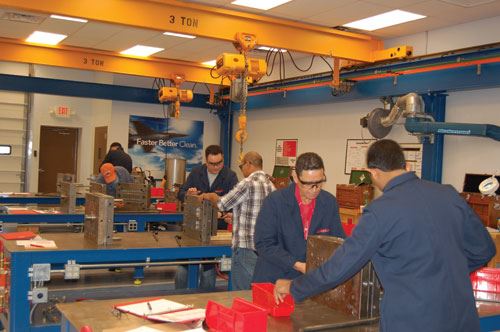
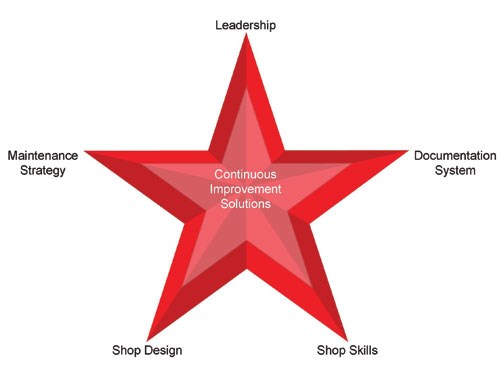
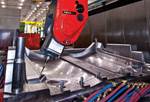









_300x250 1.png;maxWidth=300;quality=90)

.jpg;maxWidth=300;quality=90)

.png;maxWidth=300;quality=90)










